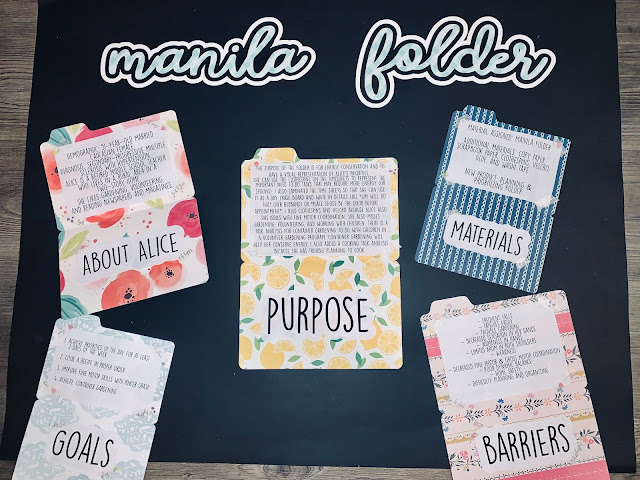Media Project
· Frequent
falls
·
Fatigue
·
Trouble
gardening
·
Decreased
sensation in her hands
·
Limited
AROM in both shoulders
·
Weakness
·
Decreased
fine motor & gross motor coordination
·
Home safety
·
Difficulty
planning and organizing
When I was brainstorming for this project, I thought about what was the biggest barrier for the client in doing her occupations. My "aha" moment was realizing that energy conservation played a key role in how Alice went about her day. We learned earlier in this course that fatigue is inevitable with MS and the 4 P's of energy conservation would be greatly beneficial for the client. I decided to focus on 2 of the P's: planning and prioritizing.

I wanted to incorporate planning and prioritizing but I didn't want it to be something like a planner that I could just buy at a store. I thought that incorporating clothespins and velcro would add a just-right challenge for the client. I categorized the day into 3 timeslots--morning, afternoon, and night. The clothespins are to represent the #1 priority for that time slot or day. For Alice, this may be cooking, cleaning, laundry, reading, gardening, and etc. I wanted to have a visual representation of what was the priority. I thought that with the clothespin having the priority velcroed to it, she could work on her pincer grasp fine-motor skills. I also laminated the timesheets so that it could be used with a dry-erase marker. This way she or her husband could write in if something was already done or if her husband planned to do that task. This was a way to also plan Alice's day and what she had to do. For example, she could write in tips to herself like "leave shoes by the door" for 4pm by the "appointment" clothespin.
One of the occupations that were important to Alice that she could no longer do was gardening. She also missed working with children as a teacher and volunteering. I decided to try and tie these all together by making a task analysis for container gardening that she could do with children in a volunteer school gardening program. She could also do container gardening at home since it requires less energy and can even be done sitting down. This way Alice can continue to preserve more "spoons".
Lastly, I added a cooking task analysis for a pasta recipe. Her husband complained of her starting to cook and not finishing. She could also add more recipes to this recipe book as I put velcro on the back so that it is removable. She would have to untie the yarn to add more recipes, but I figured that would also be something that could improve fine-motor coordination.
I learned during this project how to apply my knowledge and creativity to the best of my ability for the client. I was able to remember hallmarks and signs that we learned in class and how to put my knowledge to use in things that I've learned like the Spoon Theory, for instance. I remembered how people with MS only have a certain amount of spoons and they want to spend them wisely. This is why I wanted to make something that would make that process easier for the client. Completing this media project impacted me in that I gained a little more confidence in my abilities to create something from nothing which I thought would be very hard and daunting. In the future, I will remember that I made an energy conservation tool from a manila folder and that I can be a creative thinker in helping a client become more independent.





Comments
Post a Comment